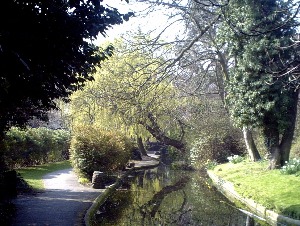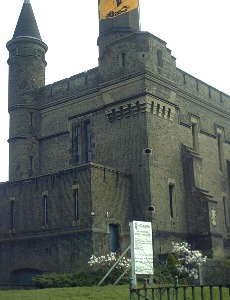![]()
Additional Information
|
STOKE NEWINGTON Additional Information |
| london-footprints.co.uk |
 |
The New River is not a very appropriate name since is neither new nor a river! It dates from Tudor times when London became unable to supply its growing population with sufficient fresh water. Edmund Colthurst had the idea of digging a channel to bring spring water from Ware in Hertfordshire. This was 20 miles away but because it is not easy for water to travel uphill it was decided to follow the 100' contour which doubled the route to 40 miles. It was 10' wide, 4' deep and run largely through open countryside. Colthurst began the project but it needed someone with more money and influence to see it through. So it was taken over by Hugh Myddleton, an MP and a Goldsmith. Even so it took longer and cost more than expected and, almost bankrupt, Myddleton had to go to the king for help who put up money in return for a share of the profits. The story has a happy ending in that the people of London got their fresh water in 1613 and by the time Myddleton died in 1631 he was a knight, a baronet and a prosperous man. |
| The New
River was in use until the 1850s/60s when there were a
number of cholera outbreaks and new public health
measures were introduced. As a result of this a new
waterworks was constructed at Stoke Newington alongside
two reservoirs. This building in the form of a medieval
castle was designed by Chadwell Mylne and built in 1854 (pictured
right). It now houses a climbing centre. At this
time the sections of the river nearest the City were
enclosed in pipes. These lower sections have been made
into a landscaped park with ornamental waterways (pictured
above). The New River - a booklet by Mary Cosh (ISBN 0 9507532 3 8 ) has lots more information with pictures and a map. The New River - walking route and information [webpage] |
 |
| CANONBURY
TOWER In the Middle Ages this was the estate of the Augustinian Canons of St Bartholomews. William Bolton, the last prior, built the 7 storey tower in the early 1500s as part of a manor house. After the Dissolution of the Monasteries the property was used by a number of court favourites. In 1570 it was bought by John Spencer, a Lord Mayor and cloth merchant, who made extensions and alteration including installing some oak panelling. After Spencer died in 1610 it was leased to a sucession of noblemen. When the last of these died in 1685 it was let out as apartments (Oliver Goldsmith was a tenant 1762-4). In the 1770s John Dawes, a stockbroker, demolished some of the monastic buildings and built Canonbury House and Canonbury Place (numbers 1-5). From 1887 - 1940 it served as a club and then a youth centre for the estate.The tower was restored in 1952 and was leased to the Tavistock Repertory Company until March 2003. |
|
|
CLISSOLD
PARK This was purchased as a public park and opened in 1889 after a campaign to save the area from development. It had originally been built as Paradise House in 1790 for Jonathan Hoare, a Quaker merchant. In 1800 it was sold to William Crawshay, an ironmaster of South Wales, whose daughter Eliza married a curate Augustus Clissold. The house has been refurbished and now provides a cafe and rooms for hire. There is an L-shaped remnant of the New River in the park and ponds which were originally dug as claypits to provide material for brickmaking. Facilities include a children's playground and an animal enclosure. There is a user group website. |
| ST MARY'S
CHURCHES The old medieval church was rebuilt in 1563. The north isle was added in 1716 and rebuilt in 1826-9 by Sir Charles Barry but removed after WWII bomb damage. Work was carried out in the 1920s but it retains its box pews and double galleries. There is a monument to John & Elizabeth Dudley. The new church (photo right) was built in 1858 with an early English style interior by George Gilbert Scott. The spire, one of London's tallest, was added by his son John Oldrid Scott in 1890. The church was repaired after WWII bomb damage. Church website |
 |
|
ABNEY PARK
CEMETERY This was opened in 1840 as one of seven great cemeteries to replace the overcrowded and unhealthy London churchyards. It was laid out by architect and engineer William Hoskings, on the site of the 17thc Abney House and Fleetwood estates, with an Egyptian syle entrance. Planned as an informal botanical garden the arboretum was laid out by Loddiges of Hackney with 2500 varieties of shrubs and 1000 types of rose. The 31 acres were never consecrated and so catered for all denominations including dissenters. The chapel in the form of a Maltese cross was last used in the 1950s. |
| By 1900 the
owners were finding it hard to cope with demand and new
burials were squeezed in between existing plots such that
by 1903 over 100000 people had been buried within the
walls. From this time Abney Park declined as the sense of
space was lost and the reputation of the cemetery began
to suffer. Memorials were vandalised and the undergrowth
ran wild until the company was declared bankrupt in 1974.
Following this more damage was incurred and the chapel
ruined until in 1979 a voluntary group persuaded Hackney
to buy the cemetery for £1. It has been leased by a trust since 1992 and is now open to visitors all the year round offering peaceful walks and hundreds of species of shrubs, trees and birds. The south lodge houses an information centre where you can find out more and obtain books, maps and leaflets which give details of graves and features of interest. There is also a programme of events and a website with much more information about Abney Park. |
|
© london-footprints.co.uk 2013
[route & what to see] [walks list]